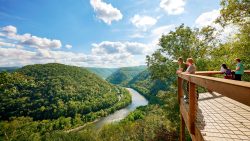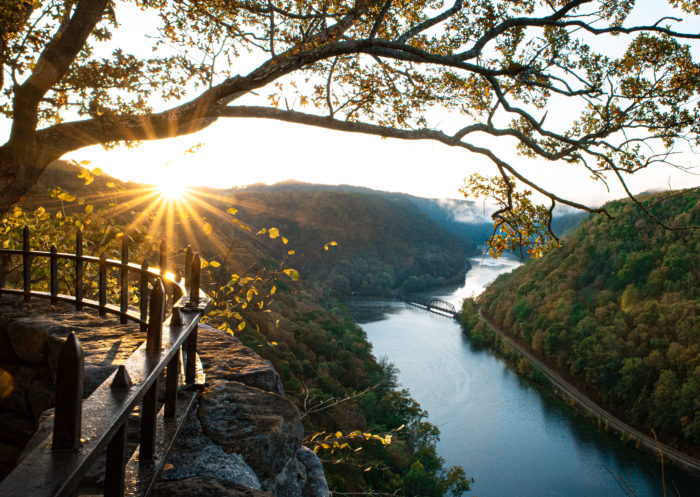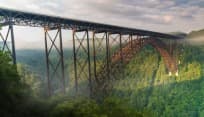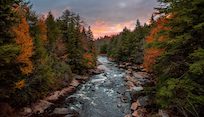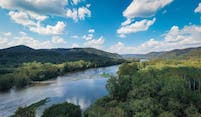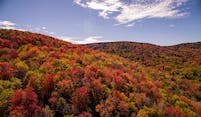What’s a “panhandle”? Explore West Virginia’s most northern and eastern arms
Out of all 50 states, West Virginia has the most distinct shape, with two panhandles extending to the north and east. How did these panhandles come to be formed? The unique borders are a combination of man-made and nature made. Learn more about them as you explore the counties, cities and towns that make up these “arms” of the Mountain State.
Northern Panhandle
The Northern Panhandle was shaped by the Ohio River along its western border. The eastern border is formed by the Mason-Dixon Line. Surveyed in the mid-1700s, the line would become known as the dividing line between the north and the south. The Top of WV CVB can provide info on all these great places:
 At the tip-top of West Virginia, Chester is home to the World’s Largest Teapot. Standing 12 feet high and 44 feet wide, the teapot is an eye-catching roadside attraction along U.S. 30. Founded in 1871, the Homer Laughlin China Company is world-renowned for its colorful Fiesta dinnerware. The company offers factory tours by reservation and operates a retail outlet stores where you can scoop up some sweet deals for your collection.
At the tip-top of West Virginia, Chester is home to the World’s Largest Teapot. Standing 12 feet high and 44 feet wide, the teapot is an eye-catching roadside attraction along U.S. 30. Founded in 1871, the Homer Laughlin China Company is world-renowned for its colorful Fiesta dinnerware. The company offers factory tours by reservation and operates a retail outlet stores where you can scoop up some sweet deals for your collection.
West Virginia’s northernmost state park, Tomlinson Run State Park offers yurt camping. These cozy round tents are ready-equipped for your stay, with a cooler, propane stove, lantern, cookware, picnic table and fire ring. The park has six hiking trails, a lake for boating and fishing, and a swimming pool with a water slide.
Three rail trails showcase the history and natural beauty of the panhandle. The paved, connected Brooke Pioneer and Wellsburg Yankee rail trails follow the Ohio River from Wheeling to Wellsburg, while the Panhandle Rail Trail stretches from Weirton all the way to Carnegie, Pennsylvania.
The Northern Panhandle’s largest city, Wheeling is home to Independence Hall, site of state’s first capital. The Wheeling Suspension Bridge, completed in 1872, spans the Ohio River to the eastern and western section of the country’s first highway, now designated the Historic National Road. You can view these landmarks and others on a walking tour of Historic Wheeling.
Enjoy a relaxing stay at Oglebay Park Resort, home of the famous Winter Festival of Lights. Amenities include two championship golf courses and the luxurious West Spa. Take a stroll on the resort’s beautifully landscaped grounds or visit The Good Zoo, home to more than 50 species of animals. Get your fill of shopping and dining at Centre Market or browse the three stories of exhibits at Wheeling Artisan Center. Stop by The Highlands for shopping or catch a show at the historic Capitol Theatre.
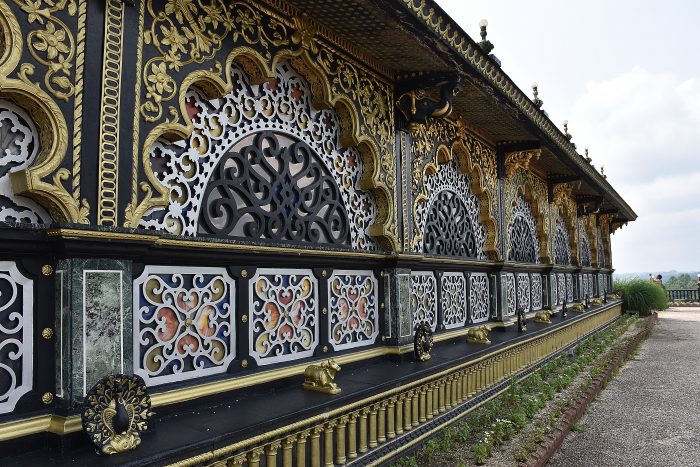 Named for the ancient Indian burial mound at its center, Moundsville holds unique treasures like the historic Former West Virginia Penitentiary. Some of the region’s deadliest criminals were once housed here, but these days the 19th century Gothic structure is open for historic tours or—if you dare—ghost hunts. You can also visit a real Palace of Gold. The magnificent Hari Krishna temple, built in the 1970s in the hills outside the city, is open for public tours.
Named for the ancient Indian burial mound at its center, Moundsville holds unique treasures like the historic Former West Virginia Penitentiary. Some of the region’s deadliest criminals were once housed here, but these days the 19th century Gothic structure is open for historic tours or—if you dare—ghost hunts. You can also visit a real Palace of Gold. The magnificent Hari Krishna temple, built in the 1970s in the hills outside the city, is open for public tours.
Outdoor lovers will want to pack a picnic to enjoy at Grand Vue Park, where you can enjoy scenic overlooks of the city. Park activities include golf (from a 9 hole par 3 to miniature golf), zipline canopy tours and an aerial adventure park.
In Wetzel County, plan a hunting and fishing excursion at Lewis Wetzel Wildlife Management Area offers 13,590 acres of woodland for hunting, while fishing opportunities abound on the South Fork of Fishing Creek that runs through the WMA. Rustic camping is available seasonally. And be sure to plan to be in New Martinsville for the Back Home Festival, which features Appalachian arts and music June 29-July 1.
Get a taste of culture and history at the Wetzel County Museum, which features exhibits of local art and history and hosts live music and other events. The area also is home to the Fish Creek Covered Bridge. Built circa 1881, the bridge is listed on the National Register of Historic Places.
Eastern Panhandle
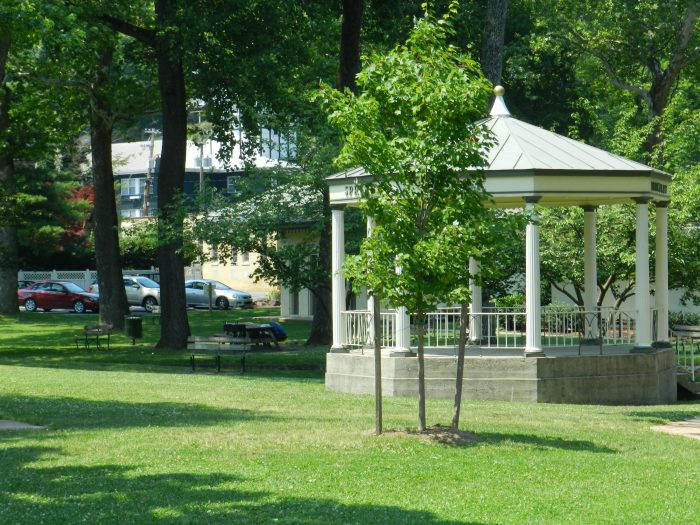 The southern portion of the Eastern Panhandle was formed during the Civil War when West Virginia split from Virginia. The new state followed existing county lines separating western Virginia counties and their neighbors to the east. To the north, a natural boundary was formed by the Potomac River and the North Branch of the Potomac River. Highlights of this diverse area range from well-known sites like Harpers Ferry National Historical Park and Berkeley Springs State Park to hidden gems in the quiet backcountry.
The southern portion of the Eastern Panhandle was formed during the Civil War when West Virginia split from Virginia. The new state followed existing county lines separating western Virginia counties and their neighbors to the east. To the north, a natural boundary was formed by the Potomac River and the North Branch of the Potomac River. Highlights of this diverse area range from well-known sites like Harpers Ferry National Historical Park and Berkeley Springs State Park to hidden gems in the quiet backcountry.
Geocache enthusiasts will love Berkeley County, which has received national recognition for its two unique gadget trails, Mystery Caches of Berkeley County and Smart Caches of Berkeley County. Plus, plenty of sweet treats and delicious dishes in Martinsburg!
At Orr’s Farm Market you can visit with the resident herd of buffalo and shop for fresh produce. In season you can bring the family out to pick your own strawberries, blueberries, pumpkins and more.
Get back to nature at Sleepy Creek Wildlife Management Area, which offers hiking trails, primitive camping, and a 205-acre lake for fishing. The 45-acre Stauffer’s Marsh Nature Reserve is a favorite spot for lovers of birds, butterflies and wildflowers.
Potomac Highlands
While in this beautiful area of the state, head to the next region: Potomac Highlands. Leading up to the Eastern Panhandle and nestled in the Potomac Highlands region of the state, Grant County is an outdoor lover’s playground. The South Branch of the Potomac River has some of the best trout fishing around, and several local outfitters offer guided fishing trips and scenic river trips.
It’s also a favorite destination for rock climbers. At NROCKS Outdoor Adventures you can scale a towering rock formation using a unique fixed anchor system or go for an adrenaline-rushing zipline canopy tour.
The area’s unique rock formations extend beneath the earth as well. Smoke Hole Caverns got its name from when the Seneca Indians used the front section of the caverns to smoke wild game. Take a guided cave tour and marvel at the stalactites and stalagmites in this underground wonderland.
Lost River State Park is best known for its stunning views from the Cranny Crow overlook, where on a clear day you can see into five counties (two of which are in Virginia). Park amenities include cabin lodging and horseback riding. Here in Hardy County you can also enjoy a getaway at a number of charming bed and breakfasts and inns, like the award-winning Guesthouse Lost River, recognized as Food & Wine Magazine’s “Coziest Restaurant” in West Virginia.
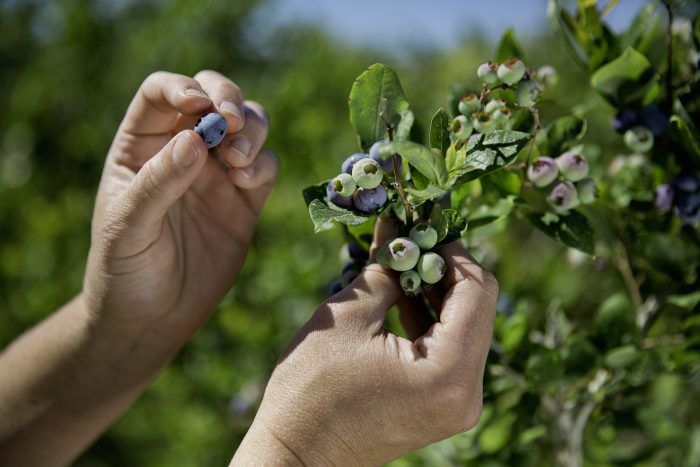
If shopping is your thing, you’ll love all the handmade and handcrafted arts and goods at Lost River Artisans Cooperative. Browse the work of more than 300 local artisans at Lost River General Store and Cafe, where you also can find local foods and a large collection of craft beer and wine.
In Hampshire County, the Potomac Eagle Scenic Rail Excursion Train passes through a gorge along the South Branch of the Potomac River, a favorite nesting and hunting spot for the American bald eagle. Passengers report bald eagle sightings on nearly every train ride! Continue your nature studies at Ice Mountain Preserve, where the unique refrigerator effect created by the talus (loose rocks) often results in ice forming inside the mountain even during summer’s hottest months.
As one of the oldest towns in West Virginia, Romney and the surrounding area is rife with historic sites and living history. Fort Mill Ridge, built by Union troops in 1863, is one of the best-preserved Civil War trenches in the nation. Fort Edwards was one of many forts guarding the frontier during the French and Indian War in the 1700s; the site contains a museum and visitors’ center.
Where is your favorite spot?
This post was last updated on February 3, 2025
